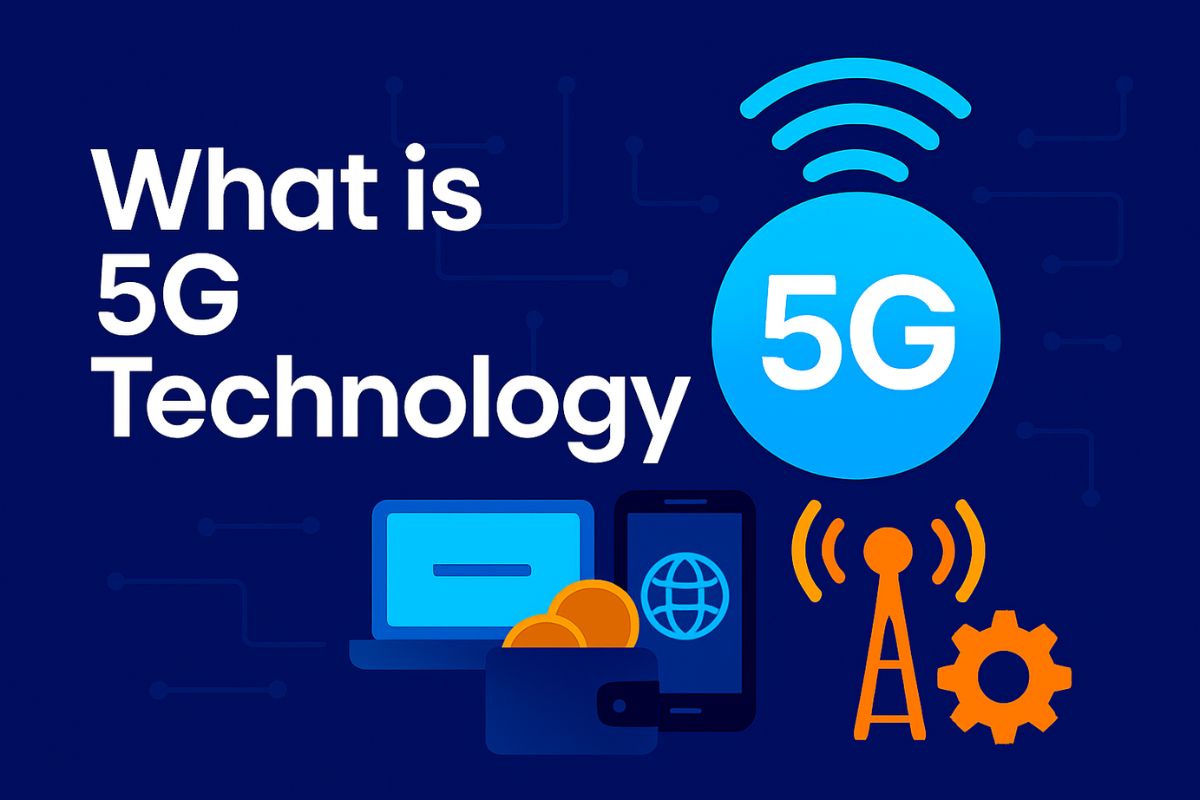5G is the fifth generation of wireless technology, offering faster speeds, lower latency, and greater connectivity than previous mobile networks. It powers innovations like smart cities, autonomous vehicles, and next-gen digital experiences. In this guide, we explain what 5G is, how it works, its benefits, real-life applications, and how it’s transforming lives in India and globally.
From streaming ultra-HD movies in seconds to enabling remote surgeries and autonomous vehicles, 5G Technology is more than just a buzzword—it’s the next big leap in digital connectivity. As the fifth generation of mobile networks, 5G is set to revolutionize how we communicate, work, learn, and live.
In this guide, we break down what 5G is, how it works, how it’s different from 4G, its advantages, use cases, India-specific developments, and why you should care—whether you’re a student, a job seeker, a tech enthusiast, or just curious.
What is 5G Technology?
5G stands for Fifth Generation wireless technology. It is the latest evolution in mobile networking, designed to:
- Deliver ultra-fast internet speeds (up to 100x faster than 4G)
- Provide extremely low latency (as low as 1 millisecond)
- Support massive IoT device connectivity
- Enable mission-critical communications
It operates on three main frequency bands:
| Band Type | Frequency Range | Use Case |
|---|---|---|
| Low-band Spectrum | < 1 GHz | Broad coverage, slower speeds |
| Mid-band Spectrum | 1 – 6 GHz | Balanced speed and range |
| High-band (mmWave) | 24 – 100 GHz | Super-fast speeds, limited range |
How Does 5G Work?
Radio Waves & Spectrum
5G uses a combination of new radio frequencies and advanced technologies like beamforming and massive MIMO (multiple-input, multiple-output) to deliver faster and more efficient data transfer.
Small Cells
Unlike 4G towers, 5G relies heavily on small cells — mini base stations placed around buildings, poles, and urban areas to boost coverage.
Network Slicing
5G allows for “network slicing” — creating multiple virtual networks on a single physical infrastructure. For example, a hospital can have a high-priority slice for remote surgery, while a student can stream YouTube on a lower-priority slice.
Benefits of 5G Technology
1. Faster Speeds
- Download a full HD movie in under 10 seconds
- Stream 4K content without buffering
- Up to 10 Gbps peak speed
2. Ultra-Low Latency
- Enables real-time responses (critical for AR/VR, gaming, robotics)
3. Greater Capacity
- Connects up to 1 million devices per square kilometer
- Ideal for smart cities and IoT networks
4. More Reliable Connections
- Stable, high-quality connections even in crowded places
5. Improved Energy Efficiency
- Smarter, greener network management with lower power usage
Real-Life Applications of 5G
Autonomous Vehicles
5G enables real-time data sharing between vehicles and infrastructure, improving traffic flow and safety.
Remote Healthcare
- Real-time monitoring
- Remote robotic surgeries
- Telemedicine with ultra-low latency
Smart Cities
From smart traffic lights to waste management sensors, 5G powers urban innovation.
Gaming & AR/VR
- Cloud gaming
- Lag-free AR/VR education and entertainment
EdTech & Online Learning
- Immersive virtual classrooms
- Real-time AI tutors and simulations
Comparison Table: 5G vs 4G vs 3G
| Feature | 3G | 4G | 5G |
|---|---|---|---|
| Max Speed | ~2 Mbps | ~100 Mbps | Up to 10 Gbps |
| Latency | ~100 ms | ~30–50 ms | ~1 ms |
| Bandwidth | Low | Medium | Very High |
| Device Support | ~1000/km² | ~10,000/km² | ~1,000,000/km² |
| Use Case | Browsing | Streaming | IoT, AR, Smart Tech |
5G in India: What’s Happening?
India rolled out 5G commercially in October 2022, with telcos like Jio, Airtel, and Vi leading the charge.
Key Updates:
- Cities Covered: Over 800 cities now have partial 5G coverage.
- 5G Spectrum Auction: Govt. raised ₹1.5 lakh crore in spectrum auctions.
- Affordable Phones: Many brands now offer 5G phones under ₹15,000.
Challenges:
- Rural Reach is still limited
- Expensive infrastructure rollout
- 5G-compatible phones required
Expert Tips & Common Misconceptions
Tips:
- Choose phones with NSA/SA 5G bands for better coverage.
- Use 5G in areas with strong signals; it can drain battery faster.
- Stay updated on 5G plans from your telecom provider.
Myths:
- Myth: 5G causes cancer
Truth: No evidence supports this. 5G operates within safety limits. - Myth: 5G replaces Wi-Fi
Truth: They complement each other. 5G is mobile; Wi-Fi is fixed. - Myth: All 5G is ultra-fast
Truth: Speeds vary by band type and location.
Tools & Free Resources
- Speedtest by Ookla – Check your 5G speed
- GSMA 5G Guide – Learn the technical side
- TRAI India – Track India’s 5G policies
Conclusion
5G is more than just faster internet—it’s a game-changer for how we live, learn, travel, heal, and play. Whether you’re an Indian student exploring tech careers, a digital entrepreneur, or simply a curious reader, understanding what 5G technology is will help you stay ahead in the connected world.
Found this guide helpful? Share it with friends, drop your thoughts in the comments, or explore our other tech explainers!
FAQs
1. What is 5G in simple words?
5G is the fifth generation of mobile network technology that offers much faster internet speeds, less delay (latency), and better connectivity than previous generations like 4G.
2. Is 5G available in India?
Yes, 5G is now available in over 800 Indian cities through telecom operators like Jio and Airtel.
3. What is the speed of 5G?
5G can offer speeds up to 10 Gbps, though real-world speeds may vary based on location and network strength.
4. Do I need a new phone for 5G?
Yes, only 5G-enabled smartphones can connect to 5G networks.
5. Is 5G safe for health?
According to WHO and government regulators, 5G is safe and complies with international health guidelines.
6. Will 5G replace Wi-Fi?
Not entirely. While 5G can reduce dependence on Wi-Fi, both technologies will coexist and complement each other.
7. What are the disadvantages of 5G?
Some downsides include high rollout cost, battery drain, and limited rural coverage in early stages.



